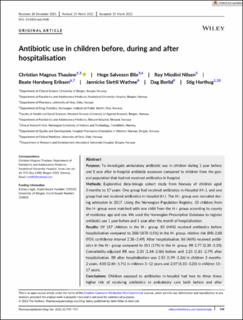| dc.contributor.author | Thaulow, Christian Magnus | |
| dc.contributor.author | Blix, Hege Salvesen | |
| dc.contributor.author | Nilsen, Roy Miodini | |
| dc.contributor.author | Eriksen, Beate Horsberg | |
| dc.contributor.author | Wathne, Jannicke Slettli | |
| dc.contributor.author | Berild, Dag | |
| dc.contributor.author | Harthug, Stig | |
| dc.date.accessioned | 2022-08-05T11:03:04Z | |
| dc.date.available | 2022-08-05T11:03:04Z | |
| dc.date.created | 2022-05-01T13:51:55Z | |
| dc.date.issued | 2022 | |
| dc.identifier.issn | 1053-8569 | |
| dc.identifier.uri | https://hdl.handle.net/11250/3010352 | |
| dc.description.abstract | Purpose: To investigate ambulatory antibiotic use in children during 1 year before and 1 year after in-hospital antibiotic exposure compared to children from the general population that had not received antibiotics in-hospital.
Methods: Explorative data-linkage cohort study from Norway of children aged 3 months to 17 years. One group had received antibiotics in-Hospital (H+), and one group had not received antibiotics in-hospital (H-). The H+ group was recruited during admission in 2017. Using the Norwegian Population Registry, 10 children from the H- group were matched with one child from the H+ group according to county of residence, age and sex. We used the Norwegian Prescription Database to register antibiotic use 1 year before and 1 year after the month of hospitalisation.
Results: Of 187 children in the H+ group, 83 (44%) received antibiotics before hospitalisation compared to 288/1870 (15%) in the H- group, relative risk (RR) 2.88 (95% confidence interval 2.38–3.49). After hospitalisation, 86 (46%) received antibiotics in the H+ group compared to 311 (17%) in the H- group, RR 2.77 (2.30–3.33). Comorbidity-adjusted RR was 2.30 (1.84–2.86) before and 2.25 (1.81–2.79) after hospitalisation. RR after hospitalisation was 2.55 (1.99–3.26) in children 3 months-2 years, 4.03 (2.84–5.71) in children 3–12 years and 2.07 (1.33–3.20) in children 13–17 years.
Conclusions: Children exposed to antibiotics in-hospital had two to three times higher risk of receiving antibiotics in ambulatory care both before and after hospitalisation. The link between in-hospital and ambulatory antibiotic exposure should be emphasised in future antibiotic stewardship programs. | en_US |
| dc.language.iso | eng | en_US |
| dc.publisher | Wiley | en_US |
| dc.relation.uri | https://onlinelibrary.wiley.com/doi/10.1002/pds.5438 | |
| dc.rights | Navngivelse-Ikkekommersiell 4.0 Internasjonal | * |
| dc.rights.uri | http://creativecommons.org/licenses/by-nc/4.0/deed.no | * |
| dc.title | Antibiotic use in children before, during and after hospitalisation | en_US |
| dc.type | Journal article | en_US |
| dc.type | Peer reviewed | en_US |
| dc.description.version | publishedVersion | en_US |
| dc.rights.holder | Copyright 2022 The Author(s) | en_US |
| cristin.ispublished | true | |
| cristin.fulltext | original | |
| cristin.qualitycode | 2 | |
| dc.identifier.doi | 10.1002/pds.5438 | |
| dc.identifier.cristin | 2020413 | |
| dc.source.journal | Pharmacoepidemiology and Drug Safety | en_US |
| dc.source.pagenumber | 749-757 | en_US |
| dc.identifier.citation | Pharmacoepidemiology and Drug Safety. 2022, 31 (7), 749-757. | en_US |
| dc.source.volume | 31 | en_US |
| dc.source.issue | 7 | en_US |

